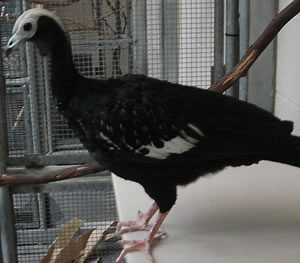Curassows, Guans and Chachalacas are pheasant-like birds that live in the tropical rainforests of Central and South America.
They are members of the Cracid family.
Curassows are turkey-sized. A guan usually weigh less than 5 pounds (2kg).
The chachalaca, which is named after its call, is the smallest of the cracids.
 The cracids are highly mobile, moving quickly through the canopy and understory. With their large, powerful feet, they are adept at running along branches.
The cracids are highly mobile, moving quickly through the canopy and understory. With their large, powerful feet, they are adept at running along branches.
The curassow climb to a high position in the rainforest, then launches itself with a few wing beats into a long, descending glide.
Curassows feed primarily on fruit-often when it is still hard and unripe. They also eat buds, leaves, insects and small frogs.
Strong and chickenlike, the beak of the cracids is often surmounted by a shiny cere. In many species, the males have a bright, hard knob on the base of their bill, as well as wattles and crests of feathers on their heads.
Curassows and guans nest in the trees. They build untidy nests of twigs and leaves in which they lay two or three eggs.
The chicks develop quickly. On hatching, they have functional wing feathers and grasping feet, and are soon ready to leave the nest and roost on branches. Within three or four days, they are able to fly.
Both parents feed the chicks and keep them under their wings while they roost. The family group stays together, along with other families, to form a mixed age flock.
Curassows are known for their highly variable, often raucous songs. The cry of a curassow can range from a whistle to a pumping, booming noise that carries well through the rainforest.
Only the males, who have very elongated windpipes, sing. However, females make low-pitched notes.